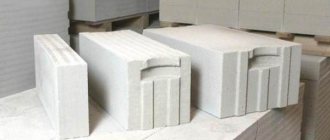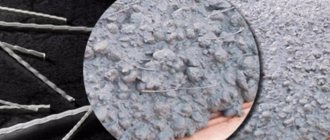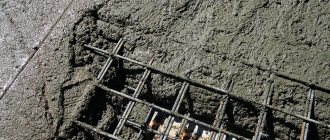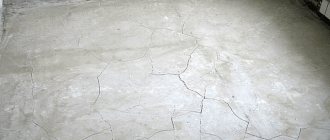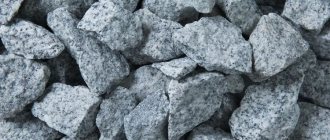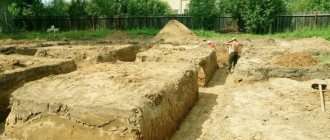At the initial stage of construction of any building, the question arises of how to properly protect the foundation from the negative effects of moisture in order to preserve it from premature destruction. The strength indicator of a reinforced concrete base directly depends on the type of hydraulic material used to finish the underground structure. The range is quite large, the materials differ in quality characteristics, cost and efficiency of use. One of the best options is a waterproofing film for the foundation.
Feasibility of application
The part of the foundation structure located in the ground is exposed to ground moisture to a greater extent, as a result of which it gradually becomes unusable. If proper protection is not created, the concrete will gradually become saturated with moisture and begin to crumble, reducing the safety margin of the entire structure.
To maintain its integrity, it is economically feasible to use film waterproofing of the foundation to maintain its structure in normal operating condition.
In addition, the material used for this purpose performs the following functions:
- creates the basis for a waterproofing layer. It is necessary to use a diffusion membrane that is considered moisture-proof, but has the ability to allow steam to pass through;
- used as an additional layer to provide complete insulation from moisture between the soil composition and the insulation or between the screed and the insulating material. In such cases, PVC film, which has good density and thickness, is used to waterproof the foundation.
Conclusion
There is no consensus among builders about whether it is necessary to use waterproofing of a wooden frame for the foundation at all. Some believe that it is not needed at all. But most experts find a solution for each case separately. It all depends on:
- type of foundation;
- concrete grades;
- technologies;
- the technology used;
- hydrological and geological features of the site;
- type and size of the building.
Only a team of experienced engineers who know all the requirements, rules, norms and standards can make accurate calculations and make the right decision.
Types of construction waterproofing films
Products used to provide waterproofing protection to foundation structures are produced by both domestic and foreign manufacturers. They are divided into the following types:
- regular roll. The thickness parameter varies between 0.6 – 2 mm. This type of film has found wide application in the national economy as a covering material for greenhouses and greenhouses. The use of such a film for waterproofing the foundation is a cost-effective solution, but for its successful use, appropriate conditions must be created, because the material is subject to mechanical stress. Today, manufacturers add special additives to such material to increase its strength;
- reinforced This film is produced in multilayer rolls. The layer located in the center is distinguished by a non-woven base or the presence of a polypropylene mesh, and the outer layers are sealed. There are perforated and non-perforated types, differing in quality characteristics and cost. The perforated layer has small holes that allow water to pass through and is used for waterproofing roofing slopes. The non-perforated version does not allow moisture to pass through. The reinforcing layer creates protection against deformation effects, increasing the service life of the material. Reinforced film, designed to protect roofs and foundations, is produced in rolls and has various color shades. When purchasing such material, you should pay attention not to its thickness, but to the density indicator, focusing on data of 100 - 250 g per square meter;
- diffusion membrane. Multilayer material that allows hydroid steam to pass through and retains water. The film is used when arranging roofing ceilings, since it, by removing steam, reliably protects structures from rotting processes. Superdiffusive film material has found application in rooms with high levels of humidity, while its cost is practically no different from the original version. Therefore, when waterproofing the foundation with film, it is recommended to use the second option, as the most reliable.
Cost of waterproofing per m2
The price of protective film depends on several factors:
- thickness;
- presence of fittings;
- the presence of an adhesive layer or tape;
- brand;
- other factors, including logistics.
For preliminary orientation and estimate calculations, you can use the data from the table:
| Material type | Three-layer polyethylene 200 microns | Polypropylene membrane | Double-layer polypropylene | Single-layer polyethylene 200 microns | Single-layer polyethylene 200 microns black (UV resistant) |
| Average cost per 1 sq.m., rub. | 29,5 | 22,6 | 21,7 | 6,2 | 6,5 |
The cost of waterproofing work involving third-party organizations varies from region to region, but on average you can estimate 200-250 rubles per sq.m. reinforced concrete foundation. The price lists of companies involved in moisture protection of foundations include figures of 500+ rubles per linear meter.
You must understand that in this case, the installation of waterproofing is inseparable from construction, so it is unlikely that anyone will undertake this work separately, and the price will be in addition to the cost of pouring.
Everything you need to know about foundation waterproofing can be found in this section.
Advantages and disadvantages
Film material is considered a worthy alternative solution to bitumen and is widely used in the construction of vertical and horizontal waterproofing of foundation walls.
Before choosing the best option, it is recommended to clarify geological survey data of the soil composition and find out all the positive and negative aspects of the material.
In addition to the fact that the film creates excellent protection against moisture, this material has other advantages:
- prevents the formation of fungus and mold;
- due to the corrugations of the surface, the material does not slide down when laid;
- the film does not rot or decompose;
- installation work is easy;
- The material has a reasonable price.
Unfortunately, builders also note negative aspects, which include:
- the presence of risks of damage to the film material due to its low level of mechanical strength;
- the need to thoroughly check and prepare the reinforced concrete surface before the upcoming installation of the film;
- the presence of connecting areas, which are considered problem areas of the waterproofing layer;
- possible damage to the material due to chemical exposure;
- damage to film by rodents. Because of this, it is recommended to comply with the storage conditions of the material;
- the ability to lose its quality during storage due to the negative effects of ultraviolet radiation. For this reason, the shelf life is limited to one year.
However, due to its good waterproofing qualities and low price, the material is widely used in the construction of foundations not only for private houses, but also for industrial facilities.
Film under the screed for waterproofing as a way to prevent moisture from penetrating into the screed
Back
Self-repair of a room is associated with the need to study the properties of the materials used and the technology of their use. One of the elements of the house (apartment) that is constantly under significant load requires special attention - the floor covering and its base. A mandatory technological requirement when pouring the base and finishing screed is the organization of temperature conditions, and in rooms above the first floor - a mandatory waterproofing device. It is unlikely that anyone would want to flood their neighbors due to burst pipes or other circumstances. This article describes how to use film under a screed, its consumer properties and sources of excess moisture.
Sources of dampness and consequences of its exposure
To build a house, land owners try to choose a location on a hill to prevent flooding and moisture penetration into the structure. But such a measure is effective if there are significant differences in the landscape; in other cases, the following circumstances are taken into account:
- Impact of groundwater. Without the use of special equipment, it will not be possible to determine the depth of underground interstratal rivers. The periodically occurring excess water pressure in their bed is sufficient for seepage in the immediate vicinity of the earth's surface.
- Wastewater. Heavy precipitation leads to the accumulation of moisture in the upper layer of the earth's surface. At the same time, the foundation walls and the base of the floor, which are in contact with the ground without the use of insulation, also gain dampness.
Consequences of lack of ventilation
- Dampness in the room and condensation accumulation. Both indicators apply equally to the premises of private and apartment buildings. They are associated with violation of technological requirements during construction. In the first case, in addition to the lack of waterproofing, a significant role is played by the malfunction of the ventilation systems. In the second case, the problem is attributed to the difference in temperature between the indoor and outdoor air. But without the occurrence of microcracks in external walls and window openings, the formation of condensation seems doubtful.
The use of waterproofing (polyethylene) allows you not to lose the water necessary for uniform drying of the screed material made from concrete or gypsum mixture, and to gain unwanted moisture from the air when using dry base materials.
Film for foundation construction
Important! Recommendations for following the technology of construction and repair of individual premises and the building as a whole eliminate the formation of dampness in residential and technical rooms. Waterproofing the base floor with film minimizes the possibility of flooding of the lower floors in case of accidents.
Consumer properties of film
For waterproofing measures, a film consisting of polyethylene of varying densities, up to 0.50 mm thick, is often used. The permissible operating temperature is from -50 to +60 degrees. Along with standard samples, manufacturers produce variants of reinforced film with a soldered mesh frame.
Main consumer characteristics of the film:
- the film reliably protects the screed from external moisture, while simultaneously creating comfortable conditions for the concrete, preventing excessive drying;
- the film is resistant to rotting, the formation of fungal colonies, and does not deteriorate for a long time;
- even a film coating assembled from several strips ensures tightness;
- the textured continuous sheet of film prevents slipping when laying or pouring the subfloor;
- the film is in an accessible financial segment and is presented in all construction stores, and competent sales consultants will help you buy the appropriate material.
Polyethylene film
The negative side of using polyethylene film to organize waterproofing under a screed is a weak indicator of the strength of the material. If the surface is poorly prepared before applying the film, tears are possible, and film folds that are not properly smoothed will ultimately lead to damage to the integrity of the waterproofing layer.
But the above disadvantage does not prevent the use of polyethylene film to limit the movement of moisture when creating strip foundations in individual construction. In this case, the film is laid after installing the formwork from the bottom and sides along the entire perimeter. This ensures uniform gradual drying of the foundation to its entire depth and achieves high quality of the final structure.
Important! Despite the simple method of laying plastic film, you should approach the process responsibly. Violation of the requirements for preliminary preparation of the protected surface and subsequent careless pouring of the screed can lead to deterioration in the quality of waterproofing.
Mode of application
The surface for laying the waterproofing film layer should be a previously formed floor screed or floor slab, pre-plastered and level. If they have a professional tool, owners carry out automated grinding of the base plane. The further procedure for preparing and directly laying waterproofing is presented in the following steps:
- Be sure to conduct a thorough inspection of the base plane to detect sharp protruding parts missed by pre-treatment and chips on the surface. Disadvantages are eliminated using improvised means.
Sanding the base for the screed
- If a significant number of defects are found on the surface of the base, then in rare cases a method is used that involves preliminary sprinkling with a sand mixture. This method is also used when there are significant differences in floor level, in order to evenly distribute the load on the waterproofing surface.
- If there are protruding mounting loops on concrete slabs, the latter are cut off and then the remaining parts of the elements are recessed or carefully ground.
- It is preferable to use a single piece of film for one room. In this case, its thickness should not be less than 0.20 mm. If the size of the room is significant and it is difficult to use a measured piece of material, it is laid with tapes overlapping each other by at least 150.0 mm and then sealed with construction tape.
- The film is laid without tension or effort on the base of the floor, extending onto the walls above the level of the intended pouring of the final screed up to 150.0 mm.
- Considering the low price of the material, it can be laid over the entire area of the room in two or more layers.
- Correctly executed installation of waterproofing material is a kind of shallow solid container.
Subsequent activities involve installing beacons according to previously prepared floor level markings and pouring screed according to technology, depending on the material used for this.
Important! To glue strips of polyethylene, you can use the old method of soldering such material. To do this, you will need a household iron and sheets of paper (newspaper). The places where adjacent strips of material are overlapped are covered with newspapers and glued together carefully and smoothly with a hot iron.
Practice shows that unjustified savings on the purchase and installation of waterproofing during the pouring of the screed, regardless of its composition, can lead to significant losses. Today, finding a suitable material to eliminate dampness in the room is not difficult. Even by using simple polyethylene as a protective layer, the owner prevents the occurrence of unwanted moisture. Thus, the organization of sufficient waterproofing is fully justified.
One of the options for organizing waterproofing is presented in the video below.
Video 1. Waterproofing.
Average score of ratings is more than 0
laminatepol.ru
Installation features
Let's look at the technology of foundation waterproofing with polyethylene film. The algorithm of actions consists of the following stages:
- First, a trench or pit is prepared, a cushion of sand ten to fifteen centimeters thick is placed at the bottom. This is necessary so that the load of the foundation is evenly distributed on the ground, and protection is created for the film from damage;
- The formwork structure is exposed.
- As soon as everything is prepared, a film is laid out on the bottom; the overlap of its strips should be at least twenty centimeters. The joining areas are taped with tape. The film is laid out in such a way that its edges protrude beyond the formwork panels by 10 - 15 cm;
- a reinforcement frame is arranged, the bundle of metal rods of which is made with knitting wire;
- concrete solution is poured, the surface of the foundation is leveled according to the rule. It is necessary to ensure that there are no voids filled with air in the concrete, for which a vibrator is used. After the concrete has hardened, the formwork panels are dismantled;
- backfilling is performed with soft sand so as not to damage the film.
It is important that the fastening of the shields is located on the outer sides so that nails or screws do not damage the film material.
When pouring the foundation slab and installing the screed, the latter is waterproofed. You should proceed as follows:
- as soon as the concrete solution hardens, its surface is leveled and polished;
- Geotextiles are laid on the monolithic slab, then polyethylene film is laid, the overlaps of which are at least 20 cm, and the joints are taped;
- As soon as the installation of the film material is completed, the surface is filled with cement mortar to form a screed.
As a rule, the composition from which the subfloor is constructed is used for this purpose.

